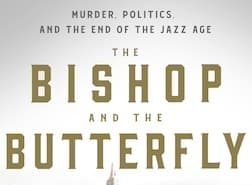A True-Life Thriller, ‘The Bishop and the Butterfly’ Bursts With the Scoundrels, Miscreants, and Opportunists of 1930s New York
Author Michael Wolraich has a journalist’s eye for the telling detail and a novelist’s knack for the salacious, the colorful, and the too good to be true. Or, perhaps it is better said, too bad to be fictional.

‘The Bishop and the Butterfly’
By Michael Wolraich
Union Square & Co.
The insect mentioned in the title of “The Bishop and the Butterfly,” a new book by Michael Wolraich, refers to a specific individual: Vivian Gordon, a woman with a knack for poetry, an eye for fashion, and a moral compass whose parameters were generous and, in the end, deadly. Gordon’s body was found at the Bronx’s Van Cortlandt Park on February 26, 1931. She was 39 years old, the victim of strangulation.
The newspapers, ever fond of alliteration, would dub Gordon “the Broadway butterfly,” but the metaphor cuts more than one way. The murder of this “shakedown artist” would send ripples not only through New York City, but through the entirety of the state and, by fiat, the country.
In the book’s final paragraph, Mr. Wolraich runs through a number of historical “what if’s” should Gordon’s death not have been the subject of tabloid interest and consequent government reform. Her spirit, he writes, “is one small forgotten thread in the glorious tapestry of New York City.”
So, yes, the butterfly effect unfolds with the inexorable logic of hindsight during the course of “The Bishop and the Butterfly,” an engrossing, sometimes heart-breaking, and invariably jaw-dropping read. Mr. Wolraich has a journalist’s eye for the telling detail and a novelist’s knack for the salacious, the colorful, and the too good to be true. Or, perhaps it is better said, too bad to be fictional.
Although there is a putative hero in the story — that would be the “bishop,” lawyer Samuel Seabury — “The Bishop and the Butterfly ” is rife with scoundrels, miscreants and opportunists. These can be raffish (Mayor Jimmy Walker), cunning (defense lawyer Samuel Liebowitz), or pathological (Harry Stein).
Polly Adler, a high-end procuress whose clientele included the literary wits of the Algonquin Club, is in the mix, as is Joseph Force Crater, a New York state supreme court justice who vanished into thin air in 1930 and whose case remains open to this day.
Did Crater meet his fate in Vivian Gordon’s Murray Hill apartment? That was the opinion of an unidentified gangster quoted in the Daily News. He claimed that Gordon had accidentally killed Crater and then sent for a pair of thugs to get rid of the body. The judge, having previously enjoyed Gordon’s favors, had been invited over in order to be blackmailed.
This hypothesis is unproven but not unreasonable: Gordon long had a strategy of extorting money from her paramours. Detectives would later discover Gordon’s little black book, a ledger that contained the names, numbers, and addresses of some 560 men. Among them were gangsters, politicians, jurors, Broadway producers, and businessmen with noms de plume like “the baking powder playboy” and “the candy Croesus.”
All of which doesn’t begin to cover the ground Mr. Wolraich traverses throughout this Byzantine story of dirty pool, tarnished reputations, and jurisprudential comeuppance. The back-slapping machinations of Tammany Hall are front and center. At its periphery is that most consummate of politicians, Franklin Delano Roosevelt. Upstanding actors are few and far between, but they do exist and their tenaciousness is, in the end and against significant odds, constructive.
“The Bishop and the Butterfly” is eminently readable and outrageously colorful, a true-life thriller in which no stone, however seamy or compromised, is left unturned.

